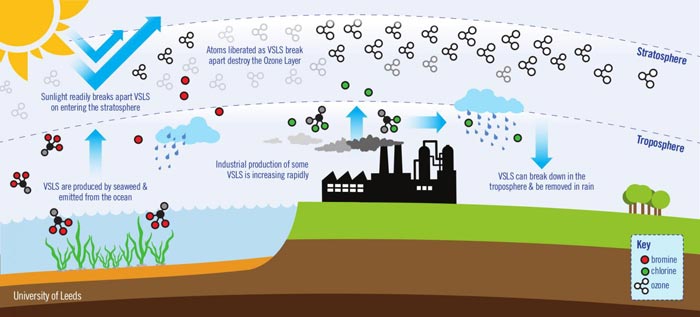New ozone-destroying gases on the rise

This is an infographic showing how VSLS deplete ozone. Credit: University of Leeds
In the new study, published today in Nature Geoscience, the scientists also report the atmospheric abundance of one of these 'very short-lived substances' (VSLS) is growing rapidly.
Study lead author Dr Ryan Hossaini, from the School of Earth and Environment at the University of Leeds, said: “VSLS can have both natural and industrial sources. Industrial production of VSLS is not controlled by the United Nations Montreal Protocol because historically these chemicals have contributed little to ozone depletion.
“But we have identified now that one of these chemicals is increasing rapidly and, if this increase is allowed to continue, it could offset some of the benefits to the Ozone Layer provided by the Montreal Protocol.”
In the study, the researchers used a 3D computer model of the atmosphere to determine the impact of VSLS on ozone and climate.
Measurements of VSLS in the atmosphere over the past two decades, provided by collaborators from the National Oceanic and Atmospheric Administration (NOAA) in the United States, were also analysed. These measurements revealed a rapid increase in atmospheric concentrations of dichloromethane, a man-made VSLS used in a range of industrial processes.
Study co-author Professor Martyn Chipperfield, from Leeds' School of Earth and Environment, said: “We need to continue monitoring the atmospheric abundance of these gases and determine their sources. At present, the long-term recovery of the Ozone Layer from the effects of CFCs is still on track, but the presence of increasing dichloromethane will lead to uncertainty in our future predictions of ozone and climate.”
The researchers found that while the amount of ozone depletion arising from VSLS in the atmosphere today is small compared to that caused by longer-lived gases, such as CFCs, VSLS-driven ozone depletion was found to be almost four times more efficient at influencing climate.
Dr Hossaini explained: “Due to their short atmospheric lifetimes, VSLS break down and destroy ozone in the lowermost part of the stratosphere. This is important, as a molecule of ozone lost in this region has a far larger impact on climate than a molecule destroyed at higher altitudes by longer-lived gases.”
The researchers also separated out natural sources of VSLS – such as seaweed in the ocean – and those released due to human activity – such as industrial processes – in order to determine the relative importance of each.
At present, naturally-emitted VSLS account for around 90% of the total ozone loss caused by VSLS in the lower stratosphere. However, the contribution from man-made VSLS compounds is increasing and appears set to increase further in coming years.
Study co-author Dr Stephen Montzka from the NOAA added: “The increases observed for dichloromethane are striking and unexpected; concentrations had been decreasing slowly in the late 1990s, but since then have increased by about a factor of two at sites throughout the globe.”
Dr Hossaini said: “It is uncertain what is driving this growth. However, it could be partly due to the fact that dichloromethane is used in the manufacturing process of some HFCs, the 'ozone-friendly' gases which were developed to replace CFCs. This would mean, ironically, that production of ozone-friendly chemicals is actually releasing some ozone-destroying gases into the atmosphere.”
Further information
The study was funded by the Natural Environment Research Council (NERC).
The research paper, 'Efficiency of short-lived halogens at influencing climate through depletion of stratospheric ozone', is published in the journal Nature Geoscience on 16 February 2015: http://dx.
Dr Ryan Hossaini and Professor Martyn Chipperfield are available for interview. Please contact Sarah Reed, Press Officer at the University of Leeds, on +44 (0)7712 389448 or pressoffice@leeds.ac.uk
Media Contact
All latest news from the category: Earth Sciences
Earth Sciences (also referred to as Geosciences), which deals with basic issues surrounding our planet, plays a vital role in the area of energy and raw materials supply.
Earth Sciences comprises subjects such as geology, geography, geological informatics, paleontology, mineralogy, petrography, crystallography, geophysics, geodesy, glaciology, cartography, photogrammetry, meteorology and seismology, early-warning systems, earthquake research and polar research.
Newest articles

First-of-its-kind study uses remote sensing to monitor plastic debris in rivers and lakes
Remote sensing creates a cost-effective solution to monitoring plastic pollution. A first-of-its-kind study from researchers at the University of Minnesota Twin Cities shows how remote sensing can help monitor and…

Laser-based artificial neuron mimics nerve cell functions at lightning speed
With a processing speed a billion times faster than nature, chip-based laser neuron could help advance AI tasks such as pattern recognition and sequence prediction. Researchers have developed a laser-based…

Optimising the processing of plastic waste
Just one look in the yellow bin reveals a colourful jumble of different types of plastic. However, the purer and more uniform plastic waste is, the easier it is to…



